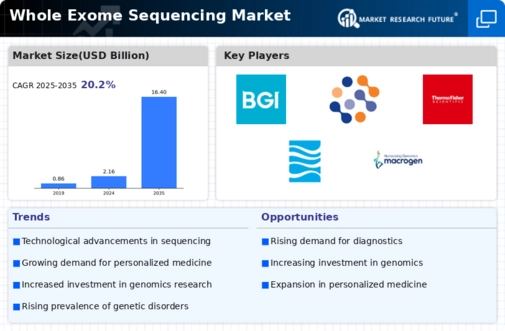Leading market players are investing heavily in research and development to expand their product lines, which will help the Whole Exome Sequencing market, grow even more. Market participants are also undertaking several strategic activities to expand their footprint, with important market developments including new product launches, contractual agreements, mergers and acquisitions, higher investments, and collaboration with other organizations. The whole Exome Sequencing industry must offer cost-effective items to expand and survive in a more competitive and rising market climate.
Manufacturing locally to minimize operational costs is one of the key business tactics manufacturers use in the Whole Exome Sequencing industry to benefit clients and increase the market sector. In recent years, the Whole Exome Sequencing industry has offered some of the most significant medical advantages.
Major players in the Whole Exome Sequencing market, including Illumina Inc. (US), BGI (China), Eurofins Scientific (Belgium), Thermo Fisher Scientific (US), Agilent Technologies Inc. (US), F.Hoffmann-La Roche Ltd. (Switzerland), GENEWIZ (US), Ambry Genetics (US), Macrogen Inc. (South Korea), Integragen SA (France), and others, are attempting to increase market demand by investing in research and development operations.
Illumina, Inc. (America) is a biotechnology company headquartered in San Diego, California, and it aids more than 140 countries. Illumina, founded on April 1, 1998, creates, produces, and sells integrated systems to study genetic variation and biological function. The business offers a selection of goods and services to cater to the markets for sequencing, genotyping and gene expression, and proteomics. For Instance in February 2023, as per Illumina Inc., the Broad Institute received the first NovaSeqX Plus Machine. The platform will assist parties wishing to access the company’s human whole genome product, lent genome/exome product, and sequencing service.
NanoString Technologies, Inc. is a publicly traded biotech company providing discovery and translation research solutions. The nCounter® Gene Expression System, the GeoMx® Digital Spatial Profiler, the CosMxTM Spatial Molecular Imager, and the AtoMX Spatial Informatics Platform are among the products made by NanoString. With the help of these four systems, researchers may see molecular interactions in three dimensions and understand how genes and proteins are expressed on a multi-genomic level about tissue shape. Products made by NanoString are based on a cutting-edge digital molecular barcoding technique developed at the Institute for Systems Biology by Dr. Leroy Hood.
For Instance In May 2022, NanoString Tehnologies, Inc. released a cloud-based process that benefits users of the GeoMx Digital Spatial Profiler and Illumina NextSeq 1000 and NextSeq 2000 sequencing devices.

















Leave a Comment